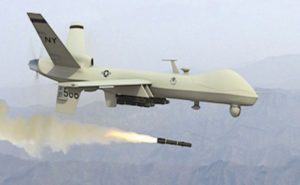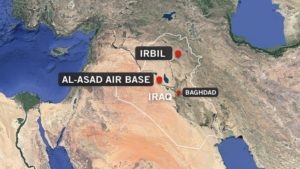Jan
13
Killing Suleimani
“This strike [was] even more justifiable [than the mission that took out Osama bin Laden], since [Suleimani] was in a foreign country directing terrorist attacks against Americans. His death is a huge loss for Iran’s regime and its Iraqi proxies, and a major operational and psychological victory for the United States.” — James Carafano, vice president for foreign and defense policy studies, The Heritage Foundation

General Qassim Suleimani (or Qasem Soleimani), commander of the Quds Force division of Iran’s Islamic Revolutionary Guard Corps (IRGC), is dead, thanks to an American drone strike approved by President Trump. Also killed was Jamal Jaafar Ibrahimi (aka Abu Mahdi al-Muhandis), leader of the Iraqi militia group known as Kataib Hezbollah, a Quds Force proxy. (This is the same group that had incited the attack on the U.S. embassy in Baghdad.)
This is GREAT news!
Why? As Heritage‘s James Carafano pointed out (and others have noted, as well):
“The Islamic Revolutionary Guard Corps, led by Suleimani, was responsible for the deaths of more than 600 Americans in Iraq between 2003-2011, and countless more injured. [Suleimani] was a chief architect behind Iran’s continuing reign of terror in the region.”
According to Michael Oren, former Israeli Ambassador to the U.S.:
“Qassem Soleimani is responsible for not tens of thousands of deaths, maybe hundreds of thousands of deaths in our region. He’s responsible for the displacement of millions. He is responsible for repeated efforts to kill Israelis, kill Americans, kill Arabs, certainly, and no figure in the Middle East, I think, is more deserving of the fate in which he received.”
But, there are those who tell us this was a mistake. It was an illegal, unjustified, unwise, irresponsible and/or dangerous act. They say that the world is “less safe” now. How do we respond to such claims? Well…
Wasn’t Suleimani on a peaceful diplomatic mission to Iraq?

This is what Iran’s Foreign Minister Javad Zarif has claimed. He also said the strike was an “act of international terrorism” and an “extremely dangerous & a foolish escalation.” Suleimani was in Iraq at the time, yes. He and al-Muhandis had just landed, and their convoy was leaving Baghdad’s International Airport. But, the rest of the claim is ridiculous. As U.S. Secretary of State Mike Pompeo put it,
“Does anybody here believe that? Is there any history that would indicate it was remotely possible that this kind gentleman, this diplomat of great order, Qasem Soleimani, had traveled to Baghdad for a peace mission — a peace mission?
We know that wasn’t true. We not only [know] the history, we know at that moment [it] was not true. Zarif is a propagandist of the first order. Most of what was suggested… was indeed Iranian propaganda. It’s not new. We have heard these lies before. It [is] fundamentally false, he was not there on a diplomatic mission trying to solve a problem. I know there was some story he was there representing a Saudi peace deal…. I can assure you [my Saudi counterparts] will share my views that he was not there representing some kind of agreement that would reduce risk….”
Was this an “assassination”?
Iran’s Prime Minister is not the only one calling this an “assassination”, as various Democrats and other Trump-critics have done so, as well. Cully Stimson, senior legal fellow at The Heritage Foundation, disagrees.
“This was not an assassination. This was a lawful killing of a combatant on the battlefield who was responsible for more than 603 American deaths, according to DOD statistics, from his own militias and thousands of American deaths or injuries by his proxies.”
Also, as Commentary‘s Noah Rothman wrote,
“This was not the covert murder of a political official. It was a strike on a terrorist commander — an eventuality the 2001 Authorization of Military Force governing rules of engagement in the age of terror fully anticipated.”

The Constitution does not prevent the direct targeting of individual members of the enemy, nor do federal statutes. Only Executive Order 12333, issued by President Reagan in 1981, states that “no person employed or acting on behalf of the United States Government shall engage in, or conspire to engage in, assassination.” The 1989 Department of the Army memorandum by W. Hays Parks points out that it is generally accepted that “assassination involves murder of a targeted individual for political purposes.” There is no indication that taking out Suleimani was for political purposes.
As Maj. Gen. Charles J. Dunlap, Jr., USAF (Ret.), writes, this part of the Parks memo is key:
“[EO 12333’s] intent was not to limit lawful self defense options against legitimate threats to the national security of the United States or individual U.S. citizens. Acting consistent with the Charter of the United Nations, a decision by the President to employ clandestine, low visibility or overt military force would not constitute assassination if U.S. military forces were employed against the combatant forces of another nation, a guerrilla force, or a terrorist or other organization whose actions pose a threat to the security of the United States.”
Did Trump otherwise act illegally/unconstitutionally? Didn’t he need authorization from Congress?
First, to be clear, this was not an “act of war” but primarily an act of self-defense, so there was no requirement for Congress to “declare war”. As law professor John Yoo has written,
“As a matter of constitutional law, President Trump did not need congressional approval to strike Soleimani or any other Iranian military officer involved with planning or carrying out attacks on our embassy in Baghdad or other U.S. personnel and forces in the region…. Even those who take the broadest view of Congress’s war powers admit that the president need not wait for legislative approval when the United States acts in self-defense.
Whether the United States could attack Soleimani in anticipatory self-defense would depend on the facts: whether Iranian forces under his control were planning or in the middle of an attack on U.S. forces or installations. But in this case, the events of the last few weeks make Trump’s legal case all the easier. Iran had already begun attacking U.S. personnel…. With access to extensive electronic and human intelligence, the Trump administration could conclude that Soleimani and his associates were planning yet further attacks on American forces.”

The U.N. Charter recognizes every nation’s “inherent right of self-defense”. The Defense Dept.’s Law of War Manual observes that, “under customary international law, [nations] have the right to take measures in response to imminent attacks.” Furthermore, “The United States has taken action to protect U.S. nationals abroad when the government of the territory in which they are located was unwilling or unable to protect them. A State need not await actual violence against its nationals before taking such action if an attack against them is imminent.”
There’s that all-important word “imminent” again. How do we determine that a threat is imminent? Factors analyzed include: “the nature and immediacy of the threat; the probability of an attack; whether the anticipated attack is part of a concerted pattern of continuing armed activity; the likely scale of the attack and the injury, loss, or damage likely to result therefrom in the absence of mitigating action; and the likelihood that there will be other opportunities to undertake effective action in self-defense that may be expected to cause less serious collateral injury, loss, or damage.” Moreover, “the absence of specific evidence of where an attack will take place or of the precise nature of an attack does not preclude a conclusion that an armed attack is imminent for purposes of the exercise of the right of self-defense, provided that there is a reasonable and objective basis for concluding that an armed attack is imminent.” Finally, as is now increasingly recognized by the international community, the traditional conception of what constitutes an ‘imminent’ attack must be understood in light of the modern-day capabilities, techniques, and technological innovations of terrorist organizations.”
Check out this quote from Jeh Johnson, former Sec. of Homeland Security (and previously General Counsel for the Department of Defense) under Obama:
“If you believe everything that our government is saying about General Soleimani, he was a lawful military objective, and the president, under his constitutional authority as commander in chief, had ample domestic legal authority to take him out without an additional congressional authorization. Whether he was a terrorist or a general in a military force that was engaged in armed attacks against our people, he was a lawful military objective.”
Also,
“[U]nder existing Office of Legal Counsel opinions, it’s plain the president had constitutional authority to use lethal force against General Soleimani as vital national interests were implicated. Therefore, no congressional authorization was required.”

It is interesting to note that, when Obama ordered the bombing of Libya in 2011 (with no Americans having been killed beforehand), Speaker Pelosi said the president did not need congressional authorization to launch such attacks or to keep U.S. forces in Libya. In 2015, Obama also launched 2800 missile strikes on Iraq and Syria without “authorization” from Congress. Where was the Democrat outrage then?
So, you might be thinking, if this was a legitimate case of self-defense against an imminent threat against the U.S., its armed forces, or its citizens, why wouldn’t the president notify Congress? Well, I imagine under normal circumstances such a “courtesy call” would have been made to the most relevant committee chairs. But, the problem here lies in the strong polarization between parties and the strong possibility that one or more of Trump’s political nemeses would leak the information ahead of time (either publicly or through back-channels). In short, the President couldn’t trust certain Democrats to keep their mouths shut, even when it would put American lives at risk and/or potentially result in a lost opportunity (or failed mission) to take out Iran’s chief terrorist.
“In my experience, since the select intelligence committees in the House and Senate were established, they have never been this political or weaponized. As for other Group of Eight members, including Speaker Pelosi, I can’t say. But, I think Adam Schiff has disqualified himself from handling classified information.” — Frank Gaffney, executive chairman of the Center for Security Policy
Was this attack by the U.S. justified?
I’ve already touched on this, but here are a few more details…
Under Suleimani’s leadership, the Quds Force and the proxies he cultivated, funded, and armed have been committing terrorist acts — bombs, missiles, etc. — throughout the Middle East and elsewhere for over 20 years. In the past few years, they’ve attacked ships in the Strait of Hormuz and downed an American drone. Most recently (Dec. 2019), “Iranian Shiite proxy forces began targeting joint US-Iraq military facilities in Iraq with increasingly sophisticated missile strikes.” The Iran-dominated Iraqi government wouldn’t help. Rocket attacks continued, and on Dec. 28 an American contractor was killed and three U.S. troops wounded. The U.S. carried out retaliatory airstrikes on five locations in Iraq and Syria, targeting multiple weapons and munitions depots linked to Iran.

Demonstrators loyal to the Iranian-backed Kataib Hezbollah militia stormed the U.S. embassy in Baghdad, trapping its diplomats and staffers in guarded safe rooms and directly threatening the American presence in Iraq. President Trump didn’t want a Benghazi-like fiasco like Obama had, and he “knew that failure to act decisively now when confronted with a similar situation was not an option.”
Piers Morgan (of all people) takes up the narrative:
“The US reportedly received credible intelligence that Soleimani was actively plotting to kill more American military and diplomatic personnel in the Middle East…. President Trump considered various military options presented to him and chose the killing of Soleimani to send Iran a firm message that yes, actually, the United States COULD and WOULD do something to defend itself.”
Was this an impulsive and reckless decision on Trump’s part?
We were told that Trump — who some have cynically proposed only did this to distract from his impeachment — was being too aggressive, destabilizing the Middle East and putting the lives of Americans and others at unnecessary risk. Worse, some people claimed he had effectively declared war on Iran or even started World War III.
According to Rothman,
“To hear Trump’s critics tell it tonight [1/2/2020], this was a reckless assault on the existing order in the Middle East, but there is no order in the Middle East — not if Iran has anything to say about it. Today, U.S. troops are in grave jeopardy as Iran will likely seek to target them in response, these same voices say, but the events of the past month made it clear they were already in jeopardy. Indeed, they are positioned to prevent conflict — as a tripwire — precisely because an attack on them is understood by America’s adversaries as something that will always be followed on with a disproportionate response.”
On 1/3, Guy Benson observed:
“Yes, the American leader’s decisive role in this strike is undeniable and crucial. And yes, there are legitimate concerns about what the complex aftermath will look like. But some events are larger and more significant than our endless, petty domestic partisan feuds. This is one of them.”

Of course, Iran did indeed respond by launching 15 (or, was it 22?) ballistic missiles at two Iraqi military bases housing U.S. troops. There was minimal damage and no casualties. It is generally considered to have been a face-saving effort by Iran, so they could say they struck back and then lie about the damage and casualties. (I saw reports of as many as 80 dead. Nope. Sorry, Charlie.) In fact, reports have also indicated that Iran told us (via Iraq) that it was coming.
Hasn’t Trump just made the situation worse? What was he thinking?!
As Trump himself said,
“We took action last night to stop a war. We did not take action to start a war.”
And from the Pentagon,
“What was sitting before us was [Suleimani’s] travels throughout the region and his efforts to make a significant strike against Americans. There would have been many Muslims killed as well — Iraqis, people in other countries as well. It was a strike that was aimed at both disrupting that plot, deterring further aggression, and we hope setting the conditions for de-escalation as well.”
Clearly, this action was about not only neutralizing an imminent threat but about a renewed policy of deterrence against further attacks. It was a warning shot, a show of strength and determination by the Trump administration that 1) Iran must not be allowed to continue as it has been and 2) the U.S. is not to be trifled with.
After the toothless retaliatory strike on the Iraqi bases by Iran, Trump de-escalated the situation rather than escalating it. He promised strong (non-military) sanctions on Iran, and he urged more involvement in the Middle East by NATO, China, and Russia. Carafano’s assessment:
“Trump’s response was measured, responsible, and proportional — just as was the drone strike that killed Suleimani.
No, Trump said, the U.S. isn’t going to fire back at Tehran like in some cinematic Wild West shootout. Instead, the U.S. will continue to take actions designed to get Iran to “be better”–actions that will further isolate and punish the regime for its destabilizing behavior.
Trump’s endgame also remains the same: limit the Iranian regime’s ability to wreak mayhem, while offering it the option of going back to the negotiating table to do a real deal — one that addresses the mullahs’ most troubling behaviors.”

Here is one final quote, this one from Townhall‘s Steve Sherman:
“Most Americans are worn out with the wars in Afghanistan and Iraq, and therefore don’t want to see a new one in Iran. The show of force that culminated in the U.S. taking out Iran’s Qassem Soleimani sent a clear message that America was not interested in regime change or a major war with Iran, but it would not hold back in taking out one of the most feared and renowned terrorists the world has ever known if given the chance. Iran got the message loud and clear.
Targeted strikes such as the Soleimani hit or munitions bombings have proven a deterrent to Iran taking more aggressive actions against the U.S. and may end up actually preserving the peace. Deterrence is the most important tool the American people have today to preserve the peace and avoid another war in the Middle East.”















